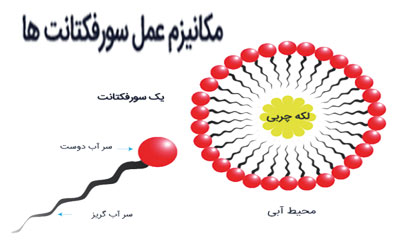Surfactants
Surfactants are compounds which, by lowering the surface tension of water, can facilitate the formation of emulsions with otherwise immiscible liquids such as oils and fat. They are widely used domestically and in industry. In recent years, the traditional soaps have been replaced by detergents that contain synthetic surfactants and other ingredients; for domestic washing of garments, these may contain water softeners, optical brighteners, and perfumes.
Surfactants are either ionic (liable to electrolytic dissociation) or nonionic (nodissociating in water). Ionic surfactants are subdivided into anionic (dissociating to a surface active anion and an inactive cation), cationic (dissociating to a surface active cation and an inactive anion), and ampholytic (assuming either anionic or cationic properties, depending on ambient conditions). The anionic surfactants are those most widely used in industry.
Because of the large number of synthetic surfactants in production, it is not surprising that they span a wide range of chemical toxic actions for aquatic organisms. However, they do have a common physico-chemical effect in that they can damage the lipid components of cell membranes. Because the surface tension of the ambient water is decreased, the lipids are less water repellant and this leads to hydration and enlargement of the cell volume. At low surfactant concentrations this enlargement is reversible. Higher concentration can cause a suppression of metabolic processes in the cells. Long-term exposure may damage the cells which then become necrotic in the later stages. These changes result mainly in an impairment of the gill respiratory epithelium. In addition, the exposure of fish to some surfactants can cause changes in the activity of respiratory enzymes, especially cytochromoxidase. Surfactants can also damage the protective layer of mucus on the skin; the layer loosens and the resistance of the fish to infection decreases. Sublethal surfactant concentrations can also damage eggs and sperm.
The toxicity of surfactants to fish is influenced by a number of biotic and, especially, abiotic factors. The age of the fish is a particularly important biotic factor.
During embryonic and larval development, the sensitivity of fish to surfactants is sometimes greater by an order of magnitude in comparison with the juvenile and adult stages. Of the abiotic factors, the molecular structure of the surfactant and the physico-chemical properties of water exert the greatest influence on their toxicity. The results of investigations into the relationship between toxicity and molecular structure indicate, for example with linear alkylbenzene sulphonates, that the toxicity to fish is markedly increased with the length of the molecular chain. A similar correlation between toxicity and chain length was observed with other surfactants. Among the physico-chemical properties of water, increasing calcium and magnesium concentrations have the greatest effect on reducing surfactant toxicity and some influence is also exerted by the pH. This may be important where surfactants are incorporated into a detergent containing water softening chemicals (e.g. polyphosphates). Where both cationic and anionic surfactants are present in waste waters their toxicity is much reduced, due to the formation of insoluble complex.
The acute toxicity of surfactants varies considerably with the species of fish. Nevertheless, these compounds and the detergents that contain them are highly toxic to fish in the majority of cases, the 48-hour LC50 ranging between 1 and 10 mg per litre. A small proportion of surfactants can be classified as having a medium toxicity (48-hour LC50 between 10 and 100 mg per litre) and a few have a very low toxicity (48-hour LC50 to 10 000 mg per litre). For the majority of surfactants, no significant differences in their toxicity to fish were recorded between the anionic, cationic and nonionic groups.
As stated above, surfactants can cause damage to the gill respiration epithelium (e.g. enlargement and vacuolation of the cells with dystrophic to necrobiotic changes). Therefore, the clinical signs of poisoning include respiratory disorders (increased respiration rate, and cyprinids gasp for air at the water surface) and later by inactivity. The characteristics in the patho-anatomic examination are an increased amount of mucus on the skin and in the gills, and congestion to oedematous swelling of the gill apparatus. The mucus is easily removed from the body surface and gills.

